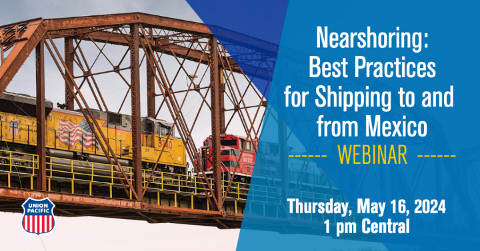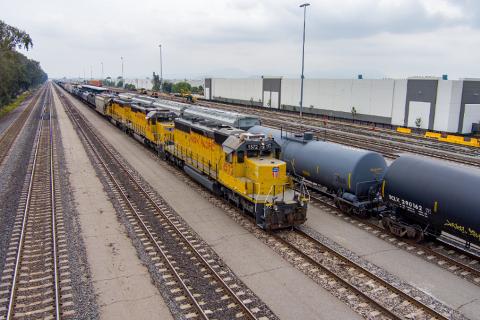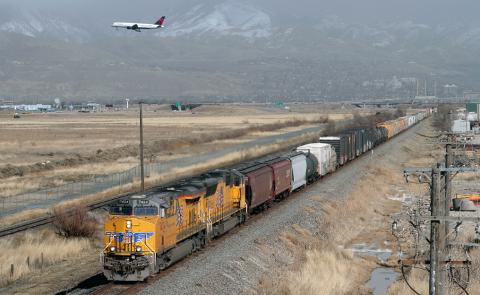The value of North American lumber production is estimated to be more than $236 billion dollars in 2023. Consumption is even higher with a projected value totaling $242 billion, according to Forest Economic Advisors (FEA).
Between production, consumption, imports and exports, the shipping industry is moving a lot of lumber across North America. But how?
For imports and exports, lumber ships overseas in intermodal containers hauled by ocean carriers. Although lumber can be shipped by barge as well, most inland shipments travel by truck or train. Understanding how lumber ships by trucks and trains and comparing the two options can strengthen lumber shippers’ supply chains and maximize returns on their share of this massive industry.
How to Ship Lumber by Truck
When lumber ships over the road, it typically travels on a flatbed truck. It can also ship in other types of trailers including dry vans, side lifters and maxi trailers. Most lumber trucks have flatbed trailers with 40 to 48 feet of loadable length, are approximately 8 feet wide and have a capacity of 48,000 lbs.
Inaccurate weight or size details can cause delays or additional charges for truck shipping, so accuracy is important.
How to Ship Lumber by Rail

Centerbeam rail cars
Railroads usually ship lumber on centerbeam rail cars, which can carry more than 200,000 pounds per car. These rail cars are designed to ship lumber, plywood, Oriented Strand Board (OSB), wallboard, fence posts, mass timber, construction materials and other building materials.
Centerbeams allow shippers to move a larger amount of lumber at one time, typically four times more per rail car than one truck. In fact, just one freight rail car carries enough framing lumber to build five and a half homes.
In 2021, U.S. railroads hauled approximately 420,000 carloads of lumber and wood products (a “carload” represents the amount of cargo that fits in a rail car). If those carloads all consisted of framing lumber, it would be enough lumber to build 2.3 million houses.
If trucks shipped that same amount of lumber instead, it would require 1.68 million trucks to haul it, which would have negative impacts on both highway congestion and greenhouse gas (GHG) emissions.
How Lumber Ships on Rail Cars
- Railroads provide centerbeam rail cars for hauling lumber.
- A load consultation provides shippers with the right loading and securement procedures to use.
- Forklifts load and unload centerbeams.
To find out how much it costs to ship lumber, building materials, construction materials, and other wood products by rail, answer a few quick questions to get a quote.
What Is the Best Way to Ship Lumber: Trucks or Trains?
Trucks and trains each have their advantages. Choosing between the two usually comes down to the volume, time, cost and environmental requirements of the shipper.
Shipping Lumber by Truck
- Volume: A 48’ flatbed truck can haul between 45,500-52,000 pounds of lumber, about a fourth of a rail car. Trucks work well for LTL (Less Than Truckload) lumber shipments and are ideal for first- or last-mile delivery.
- Ease of loading: Flatbed trucks are easily loaded/unloaded using a forklift.
- Transit time: Trucks travel at an average speed of 50 mph, offering quick delivery for short to medium distances. However, it is important to note that trucks can be delayed by weather, construction and roadway congestion. Lumber shipping trucks must also be tarped to protect product from the elements.
- Cost: Rates for truck shipping can vary based on availability. In recent years, driver shortages and enforced hours of service requirements have strained capacity, driving spot prices higher.
- Environmental Impact: Trucks are significantly less fuel efficient than trains and contribute to a greater percentage of total greenhouse gas emission. In fact, if 25% of the truck traffic moving at least 750 miles was shipped by rail instead, annual greenhouse gas emissions would fall by approximately 13.1 million tons.
Shipping Lumber by Train
- Volume: Shipping by train is ideal for large volumes of freight, including lumber. One centerbeam rail car can carry up to four trucks’ worth of product, making it easy to ship larger volumes. Rail cars can also accommodate oversized lumber shipments.
- Ease of Loading/Unloading: Centerbeam flatcars are one of the easiest types of rail cars to load and unload with a forklift. An experienced operator can usually load/unload a full rail car in less than an hour.
- Transit time: Although trucks are known for offering fast delivery, transit times for rail and over-the-road trucking can be comparable. Trains operate 24/7, are not susceptible to roadway congestion or construction delays, and can move shipments over long distances quickly and efficiently.
- Cost: Rail shipping is considered one of the most cost-effective modes of transportation, especially for large volumes traveling long distances. Due to its ability to move large quantities of lumber at a time, rail shipping usually has a lower cost-per-ton-mile (the cost of moving one ton of freight one mile) than truck shipping. How much does it cost to ship lumber by rail? Get a quote here.
- Environmental Impact: Trains are four times more fuel efficient than trucks, so they have a much smaller carbon footprint. This makes trains an ideal transportation mode for those seeking to lower their carbon footprint.
How to Ship Lumber by Train Without Railroad Tracks

Forklifts move lumber between trucks and trains in a process called transloading
If rail is a good fit for your lumber shipments but trains don’t service the origin and/or destination, transloading can give you access to a rail shipping solution for lumber, building materials, construction materials and other wood products.
When lumber is transloaded, it is moved from trucks to centerbeam rail cars or vice versa, allowing shippers to combine the cost and environmental advantages of rail shipping with the flexibility of over-the-road trucking for the first and/or last mile.
What Is the Most Sustainable Way to Ship Lumber?
Trains are the most environmentally responsible way to ship freight, including lumber, by land. On average, railroads move one ton of freight nearly 500 miles per gallon of fuel, making them four times more fuel efficient than trucks. Because trains are more fuel efficient, shipping lumber by train instead of truck reduces GHG emissions by up to 75%.
Converting more over-the-road lumber shipments to trains would lower GHG emissions further. Looking at the industry overall, if 25% of the truck traffic moving at least 750 miles traveled by rail instead, annual greenhouse gas emissions would fall by approximately 13.1 million tons. If 50% of the truck traffic moving at least 750 miles went by rail instead, greenhouse gas emissions would fall by approximately 26.2 million tons.
Questions to Ask Before Shipping Lumber by Rail

Lumber train
If you are interested in shipping lumber, building materials, construction materials and other wood products by train, the railroad will want to know the following information:
- Where are you shipping from? Where are you shipping to? Answering these questions will help the railroad understand the length of the trip and whether one railroad can handle the entire shipment or if other rail carriers should be involved.
- Are there railroad tracks at the origin or destination? If the origin or destination is not rail served, it is not a dealbreaker. Railroads work with logistics partners that design transloading solutions to give lumber shippers without railroad tracks access to shipping by train.
- How much and what type of product are you shipping? Railroads will need to understand the type of lumber, size (i.e., length), amount and weight of the lumber shipment. They will also want to know if you plan to ship on a weekly or annual basis.
How Much Does It Cost to Ship Lumber by Rail?
The cost for a railroad to ship lumber will depend on the size of the shipment and how far it must travel. In general, shipping by rail has a lower cost-per-ton mile (the cost to ship one ton of freight one mile) than shipping by truck.
To learn how much it costs to ship wood, lumber, construction materials, and wood products like plywood, OSB (Oriented Strand Board), wallboard, fence posts and mass timber by rail, get a quote.
How Do I Get a Freight Rate for Shipping Lumber?
Getting a freight rate for shipping lumber is as easy as answering a few questions. Complete this brief form and a lumber shipping expert will be in touch to provide you a lumber shipping quote.
Learn More
To learn more about how lumber ships by train and how railroads can support your changing supply chain needs and reduce your company’s carbon footprint, answer a few questions and an expert will be in touch.
Related Articles









